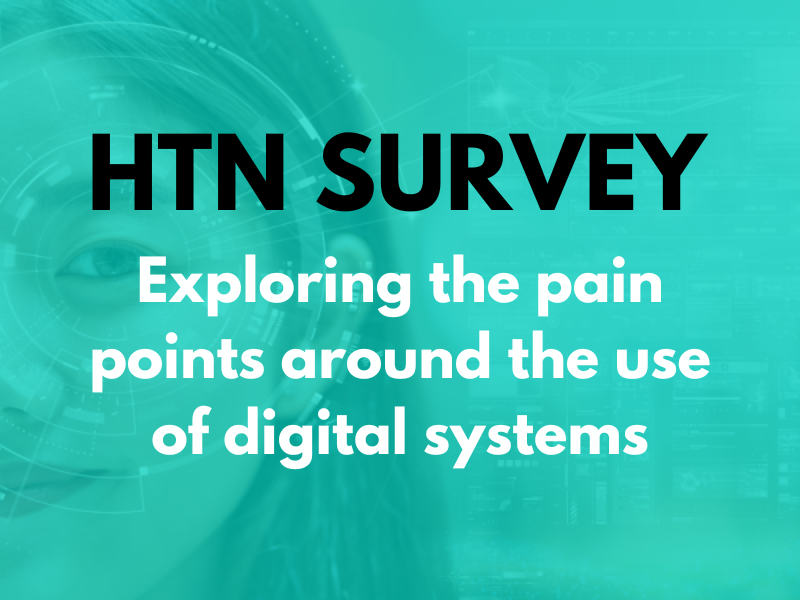At HTN Digital ICS, digital leaders got together to discuss how they are tackling the challenges of system-wide working, sharing their own approaches and showcasing innovations supporting the formation and development of digital integrated care systems (ICSs).
We were joined for the first session of the day by accuRx, a software company working with the NHS in primary and secondary care to improve communication with and about patients, and information sharing. Posing the question ‘How ready is your ICS to work with digital suppliers?’, accuRx shared their thoughts on the questions ICS leaders should look to ask when looking to procure suppliers that truly meet their needs in delivering integrated care across the whole system.
Senior Clinical Lead Satya Raghuvanshi was present for the session along with Operations Lead Sarah Garner and Policy Lead Matt Honeyman.
To begin, the panel set out an overview of accuRx and their vision for a health system with communication at the heart of it, emphasising that patients themselves are central to this vision. Satya said, “Our platform enables healthcare staff to communicate with their patients and each other, and that includes everything from managing triage across care settings to holding virtual consultations, remote monitoring, sharing and accessing GP records and communicating directly with patients, to either gather more information or provide asynchronous care.”
To initiate discussion, Satya posed a question to the webinar audience: how ready do you feel your local ICS is to launch in July 2022? The most popular answer was that respondents felt somewhat ready, with 52% selecting that option; 26% of respondents, meanwhile, said that they did not feel ready and 4% said they felt extremely unready.
To support people on their digital ICS journey, Satya set out the process of suppliers contracting with ICSs: discovery, market engagement, procurement, implementation, monitoring, success.
Discovery
“Kicking off with discovery first,” Satya said, “It’s really just understanding what is the lay of the land currently, and how ICSs and suppliers can work together based on that information.” She noted that early involvement of NHS staff and patients to understand how digital tools are being used on the ground is critical for this stage. “From our experience, we tend to see that people have a really good understanding of primary care, but services like secondary care and community mental health services seem to be more fragmented, and there’s less clarity about what digital tools are being used and how they are being used.”
accuRx framed the discovery stage around five key questions for ICSs to ask:
- Which digital suppliers are already being used across the ICS?
- What problems are those suppliers solving?
- How well are they solving these problems?
- What is the patient experience?
- Are they able to operate at scale to support system-wide challenges?
“The way that we do that, and the way that suppliers can engage with that, is making that information really visible, sharing it transparently and openly,” said Satya. “You should really push suppliers to ask how a product is being used, which products are being used, who is using them. Suppliers should feel comfortable about sharing this information, especially towards supporting ICS working.
“Ultimately, it comes down to the users at the end of the day,” Satya continued. “They are the ones who are going to be on the frontline, navigating some of these digital tools, trying to support patient care. We are heavily focused on really involving users in product development. We need to truly understand the digital needs of your patients and the service users. It goes beyond engagement and feedback in the form of patient questionnaires, sometimes convening things like patient panels won’t be enough because it can leave you with a slightly incomplete picture of user needs. There’s a key distinction between asking for feedback on digital services and actually involving those who use it in design… it’s also something that we think about as suppliers in terms of how to drive product, user research is at the heart of all the products that we build here.”
Satya went on to highlight the importance of asking questions. “Just because something is being procured, doesn’t mean it’s necessarily meeting user needs. There can be real delta between what is being procured at a local or regional level, and what users on the ground are doing.”
Market Engagement
Moving on to market engagement, Satya stated that collaboration between ICSs and suppliers should be proactive. In order to obtain effective market engagement, accuRx pointed out the need for “identification of needs and core requirements clearly defined including setting, scope and use case”; “early engagement of suppliers and their ability to support the broader ICS digital strategy and vision”; and “clear timelines for market engagement and the bid tendering process”.
Sayta added, “Consideration of information governance and security is key. Sometimes this is left quite late until procurement is ongoing… suppliers can really support some of this work, they can share how they thought about privacy and security early.” Covering how accuRx handle this when working with ICSs, Satya said, “We encourage ICSs to engage in this discussion really early, even before a bid or tendering process, to make sure that all your suppliers are thinking about this really mindfully given that they will be impacting patient care and delivery.”
Procurement
Next is the procurement stage, with Operations Lead Sarah taking the lead on the discussion.
“Procurement is the third pillar of how ICSs and suppliers work best together,” said Sarah, “and there’s obviously a huge amount of process and it’s important to get this right.” accuRx believes that procurement should be transparent, consistent and ultimately benefit patients. “What that means is being transparent about the timelines for the procurement, but also being really transparent about what are the need-to-haves versus the nice-to-haves, and making sure that it’s a really collaborative process.”
Sarah noted that new guidance is due to be released through the Providers Selection Regime “that seems to be taking a slightly more pragmatic approach to procurement, which has been very much welcomed… where you’ve got those suppliers and solutions in place that are already embedded, and it comes round again to re-procure, it shouldn’t need that same long process to re-engage those suppliers. That time, which could be better spent on giving patient care, should not be going into bureaucracy for the sake of bureaucracy.” This should allow systems to better coordinate care and focus on continuity of service provision.
Sarah highlighted the areas that accuRx suggests ICSs and digital suppliers think about during the procurement stage. “From an ICS perspective, we love it when our providers are thinking really carefully about their procurement decisions and processes,” she said, “and that they’ve done all of the market engagement.” She emphasised the importance of completing an appropriate level of engagement dependent upon the size of the ICS and the number of organisations involved. Another thing for ICSs to consider is “making sure there is a long-term and joined-up procurement exercise.”
From the digital supplier side, Sarah noted that customers should expect “system-wide pricing and economies of scale”, along with “contract flexibility” and “transparency of current and future capabilities”.
Implementation
Moving on to implementation, Sarah commented, “At the point that the contract is signed, that is not the end of the road for the collaboration with your provider, and at accuRx we actually think that signing the contract is the real beginning of the journey.” The aim of the implementation period, she said, is to “make sure that you get the maximum value out of products as quickly as possible. The best digital suppliers are not motivated by selling, they’re motivated by the value that comes out of it, the number of users who are using the software.” The buying organisation and the users also have responsibilities here that must be planned in advance, “especially if that crosses organisational boundaries, where you need to pull in different implementation teams or transformation functions or learning and development functions in different organisations. That involves forward planning and engagement with multiple teams as part of the wider organisation implementation plan.”
The next thing that accuRx do is review how prepared a client is via a Readiness Assessment, which highlights any outstanding actions that need to be taken prior to onboarding, ensures that users are primed for a successful implementation, and maximises their chance of a smooth and effective onboarding experience.
“The second key part of preparing for a really good implementation programme is understanding the local context,” shared Sarah. “No two areas are the same and those differences in context we know from experience will cause issues later down the road. It’s much better to all be on the same page as we start off.”
Monitoring
The fifth stage is monitoring. “I cannot stress this point enough, about using real, actionable data to understand the value that current solutions are generating,” said Sarah. “You will have promises and discussions that happened at the point of procurement, and then that could be a different picture to what happens on the ground when a product or solution is implemented. Every decision that you make as a buyer should be based on evidence and equally, on the supplier’s side, every decision and iteration that we make should be also based on evidence.
“This isn’t about data to satisfy reporting requirements,” she said, “this is about real business intelligence. We find that the customers who we work with who get the most value out of our products are the ones who are asking for demos of this before they even buy it, they’re interrogating the power of that intelligence, they make great use of our generic dashboards but where they need more bespoke analysis they are asking for that from their customer success managers.”
Digital suppliers, Sarah continued, should be looking at the same data to understand which of the product features are the most popular and which are easiest to use, and using the data to understand whether commitments to buyers are being met.
Next, Sarah shared an example of the kind of dashboards that accuRx believe are the most useful. In 3 seconds, the example shows, you should be able to tell if the KPI is performing well or badly; in 30 seconds, you should be able to tell why; and in 300 seconds, you should be able to answer the question, “What should I do about it?”
Success
The final phase is success. “There’s a huge piece of work that is critical to success of any digital tool,” said Satya, “and that’s really the ability to try for transformational change by engaging those end users and patients, that speaks to the cultural change and the impact that you want to have as an ICS as the ultimate measure of success.”
accuRx sees measuring success as a closed loop system, featuring four key components: tools and support, ongoing monitoring, continual engagement with suppliers using data to feed into their innovations, and user feedback. “Critical to that user feedback is having an avenue where users and patients can get in contact and identify where they might need support.”
Matt took over at this point to run a question and answer session with the webinar respondents. You can watch this section of the presentation on the video below at 44 minutes.
Many thanks to Satya, Sarah and Matt for joining us; if you’d like to watch the full webinar, you can do so below. If you have any questions or would like to understand how accuRx can help your organisation, please get in touch at partnerships@accurx.com





